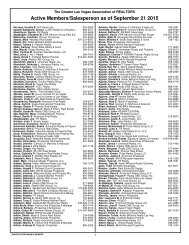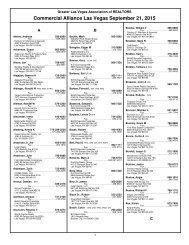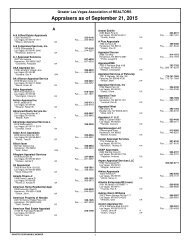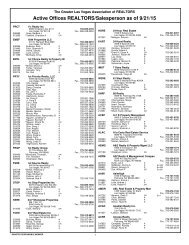[ 4 ]
14special report - Greater Las Vegas Association of Realtors
14special report - Greater Las Vegas Association of Realtors
- No tags were found...
You also want an ePaper? Increase the reach of your titles
YUMPU automatically turns print PDFs into web optimized ePapers that Google loves.
FINANCE<br />
NEW<br />
QUALIFIED<br />
MORTGAGE<br />
(QM) RULE<br />
[ BY JIM LOSELL, AFFILIATE MEMBER ]<br />
The Consumer Financial Protection Bureau<br />
recently released the final rule to establish<br />
new standards for all mortgages including<br />
loans called “Qualified Mortgages.” These<br />
loans are deemed ultra-safe. The final<br />
regulation gives lenders legal protection<br />
for Qualified Mortgage Loans, but only for prime loans.<br />
A prime loan has an interest rate that must be close to<br />
the national average prime mortgage rate.<br />
The basic premise of the rule will require lenders to ensure<br />
that borrowers have the ability to repay the loan. Lenders<br />
are required to verify specific underwriting standards<br />
including: current income or assets, employment status,<br />
credit history, monthly payments on the mortgage<br />
and any other mortgage related obligations and loans<br />
associated with the property, other debt obligations, and<br />
the monthly debt-to-income ratio.<br />
This new rule eliminates no-doc or low-doc loans and<br />
prevents lenders from basing their decisions on teaser<br />
rates. The rule also bans pre-payment penalties on<br />
certain fixed-rate products.<br />
The ability-to-repay rule is expected to take effect 1/10/14.<br />
The regulation defines a new category of loans called<br />
Qualified Mortgages. These loans are guaranteed to<br />
comply with the ability-to-repay requirements. When<br />
applying for a Qualified Mortgage, the borrowers debt-toincome<br />
ratio cannot exceed 3% of the total loan amount<br />
(some fees on prime loans are excluded). Lenders are<br />
required to verify a borrowers income. The loan cannot<br />
have characteristics of nontraditional mortgages.<br />
Of these, the one causing the most buzz is the 43%<br />
debt-to-income ratio. In general, the standard today on<br />
a conventional loan is 45%. Both are a jump from the<br />
rigid 36% debt-to-income ratio when I started in this<br />
business.<br />
The Consumer Financial Protection Bureau acknowledges<br />
that one of the industry’s biggest fears about the Qualified<br />
Mortgage rule is no one is going to make loans outside<br />
the criteria so they are going to allow temporary flexibility<br />
for debt-to-income requirements, most likely for seven<br />
years. The rule allows lenders to refinance existing risky<br />
mortgages like interest-only and adjustable rate loans to<br />
more stable standard loans without having to meet the<br />
full underwriting process under the new rule.<br />
According to CFPB Director Richard Cordray, “Our goal<br />
here is not only to stop reckless lending, but to enable<br />
consumers to access affordable credit.” He went on to<br />
say “We can draw up the greatest consumer protections<br />
ever devised, but if consumers cannot get credit, then<br />
there is nothing to protect.”<br />
A lender’s goal should have always been to get the<br />
borrower into a sustainable mortgage loan. We did it for<br />
years and now we are back to basics. As a seasoned<br />
mortgage professional, with 28 years of experience,<br />
I don’t see this new rule changing the way most<br />
responsible lenders are closing business in the industry<br />
today. There are still programs like FHA and VA to help<br />
borrowers who may need more flexibility. n<br />
[ 23 ]<br />
SOUTHERN NEVADA REALTOR ® MARCH 2013 www.LasVegasRealtor.com


![[ 4 ]](https://img.yumpu.com/54356952/23/500x640/-4-.jpg)

![[ 4 ]](https://img.yumpu.com/54357044/1/190x245/-4-.jpg?quality=85)

![[ 4 ]](https://img.yumpu.com/54357014/1/190x245/-4-.jpg?quality=85)
![[ 4 ]](https://img.yumpu.com/54357011/1/190x245/-4-.jpg?quality=85)




![[ 4 ]](https://img.yumpu.com/54356947/1/190x245/-4-.jpg?quality=85)